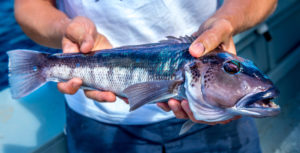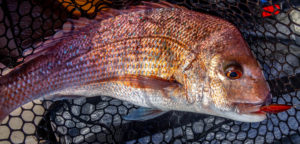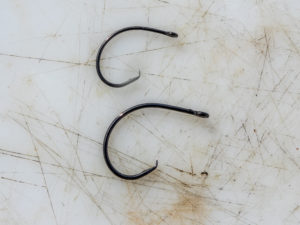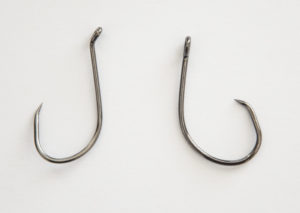NZFN have kindly given permission for FishCare to reproduce this article, originally published in 2014
One idea that has wide circulation among anglers is that it is best to use plated hooks (as opposed to stainless steel hooks) as they ‘rust out’ of a fish, where stainless will not. Do hooks ‘rust out’ of fish? Certainly most plated hooks will corrode faster than stainless hooks but the surprise is that the longer retention time of the stainless hooks did not mean higher fish mortality.
The problem apparently is that the heavy metals from the hook plating get into the bloodstream of the fish, either directly or via the gills, as the plating dissolves. The studied fish typically stopped feeding, become lethargic, and lost condition. Dark, discoloured wounds formed around the hook site. At least one major hook manufacturer, Mustad, discontinued the use of cadmium finishes as a result of this report.
Consider, on the other hand, that surgeons use inert stainless steel hardware to fix broken bones in humans — screws, plates and the like — that are often left permanently in the body with no detrimental effects. It appears that the often-criticised practice of using stainless steel hooks in lures or baits may in fact be the correct thing to do after all.
Barbless hooks
A study was also done comparing barbed and barbless hooks in the throat region of fish. After 120 days, 80% of barbed hooks were in the same position or had dug in deeper, 9% were loose in the stomach, and 11% were gone. By comparison 52% of barbless hooks were gone, 35% were loose in the stomach, while only 12% were in the original position or deeper. Fish with hooks loose in the gut showed no signs of infection from them.
My own experiences of barbless hooks are that they are easier to set; easier to unhook (an important thing for the fish or if you stick yourself with one); and that I don’t lose any more fish than I do with conventional barbed hooks. Like any other Kiwi fisherman I am not so high-minded that I use barbless hooks all the time. I mostly use barbed hooks, with the knowledge that I can press down the barbs with my fishing pliers anytime that it becomes necessary to avoid damaging undersized fish while unhooking.
The following points were indicated by the studies I read:
- Mouth-hooked fish often shed hooks rapidly
- More deeply hooked fish can sometimes shed hooks but this may take months
- Stainless hooks take longest to shed, but cause less mortality than plated hooks
- Fish can shed barbless hooks around 80% of the time
- Cadmium and tin-plated hooks are implicated in fish mortality due to heavy metal poisoning
- Mouth and lip-hooked fish survive better than those hooked more deeply
Snapper specifics
This last point is an important one as various studies conducted on New Zealand fish have underlined the fact that hook placement is a key factor in the survival of released or escaped fish. In the late 1990’s, local scientists investigated the effects of hooking on snapper. Two papers published were: Investigation of snapper release mortality from recreational line by Jeremy McKenzie and John Holdsworth; and blue cod: Large hooks reduce catch-and-release mortality of blue cod in the Marlborough Sounds of New Zealand by Glen Carbines.
 Snapper (in the north) and blue cod (in the south) are the two most highly fished-for recreational species, so the results of these studies are significant. Each study was carried out in prime recreational areas for the specific species at the time: the Hauraki Gulf, in the heart of SNA1, for snapper and the Marlborough Sounds for blue cod. The methodology used was similar: fish were caught by standard hook-and-line methods using bait, with variations in hooking and handling noted. Fish were then kept in holding cages for a period (14 days for cod and 15 days for snapper) with a ‘control’ group of fish, and monitored by divers.
Snapper (in the north) and blue cod (in the south) are the two most highly fished-for recreational species, so the results of these studies are significant. Each study was carried out in prime recreational areas for the specific species at the time: the Hauraki Gulf, in the heart of SNA1, for snapper and the Marlborough Sounds for blue cod. The methodology used was similar: fish were caught by standard hook-and-line methods using bait, with variations in hooking and handling noted. Fish were then kept in holding cages for a period (14 days for cod and 15 days for snapper) with a ‘control’ group of fish, and monitored by divers.
For both species of fish, the key factor to fish mortality was shown to be hook placement. Mouth-hooked fish showed little, if any, mortality. No lip-hooked blue cod died in the study period, and only about 4% of the snapper. It was a different story with fish hooked in the throat, gills or gut, however. Carbines’ study of blue cod showed 25% mortality of deep-hooked released fish over the two-week period, while the figure for McKenzie and Holdsworth’s investigation showed mortality figures of around 75% for deep-hooked snapper.
The blue cod study also investigated how the difference in hook size affected hook location, comparing 1/0 and 6/0 hooks. There was little difference between the two hook sizes in actual capture results, except that about half the cod caught on the 1/0 hooks were gut-hooked (and 50% of these died), while no cod were deep-hooked on the 6/0 hooks, and they all survived. This finding led directly to a recommendation from the Ministry of Fisheries that anglers should use at least size 6/0 hooks for blue cod fishing.
The snapper study did not look at this aspect, but it is probably fair to assume that a similar approach holds true: bigger hooks reduce gut hooking, which equates to a much higher survival rate of hooked and released fish. This means that we can have a much higher survival of released fish if we alter our fishing practices to avoid deep hooking them as much as possible.
Lures and baits
One American study concluded that the use of baited hooks caused higher mortality among returned fish than lures, as baited hooks tended to deep-hook fish more regularly. This was supported by an Australian study showing baited hooks produced deep hooking around ten times more than lures did. Fish tend to strike at lures and are quickly hooked (or missed), rather than having time to swallow them, as they may have with natural baits.

The increasing popularity of soft-bait and slow-jig fishing in New Zealand (especially in SNA1) would seem to be beneficial in reducing released snapper mortality in several ways. First, lures tend to reduce hooking of small fish that must be returned. Secondly, lure use would appear to result in mostly mouth-hooking, with a much higher survival rate. Although a big fish can sometimes engulf a lure, small fish usually cannot if a reasonable-size artificial is used.
Here are some practices to avoid deep-hooking fish:
 Non-offset circle (recurve) hooks result in a very high incidence of mouth hook-ups, which translates into a much higher survival rate of released fish.
Non-offset circle (recurve) hooks result in a very high incidence of mouth hook-ups, which translates into a much higher survival rate of released fish.- When bait fishing, fish with rod in your hand, not in the rod holder, and strike fish quickly, even if you miss some takes by striking early, to reduce deep hooking.
- Fishing with lures rather than cut baits results in a much higher percentage of mouth hook-ups and less mortality in released fish.
- As a general principle (indicated by the blue cod study mentioned) small hooks are much more easily swallowed by smaller fish which have to be returned, but may not survive. Larger hooks greatly reduce deep-hooking resulting in much higher survival rates. In the case of snapper, a 5/0 or 6/0 should be considered a minimum size.
Combining all of these aspects, it seems that the most fish-friendly way to go when fishing with natural baits would probably be to use barbless stainless-steel circle hooks of 5/0 or more ‑ or use lures, but adoption of any of these aspects – larger hooks, stainless hooks, circle hooks, or lure fishing – will help reduce juvenile mortality.



